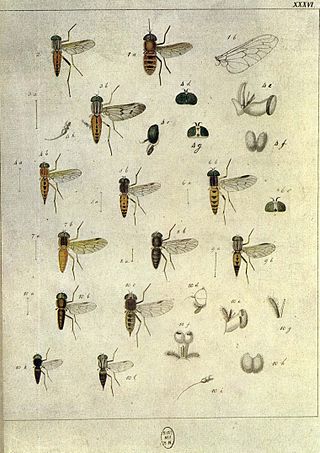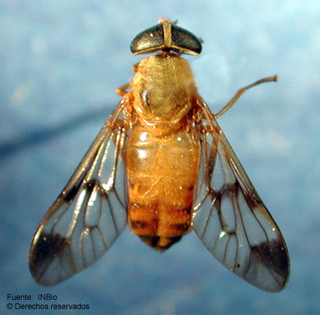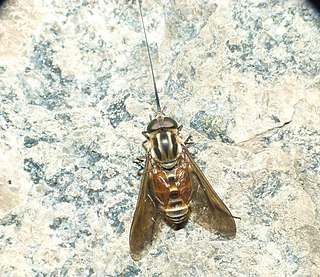
Silvius is a genus of flies in the family Tabanidae.

Pangonius is a genus within the horse-fly family (Tabanidae), often misspelled as Pangonia; Latreille originally published the name as Pangonius in 1802, emending it in 1804 to Pangonia, but the emendation is not valid under the International Code of Zoological Nomenclature. Some species that were earlier placed in this genus are now in the genus Philoliche.

Diachlorus is a genus of biting horseflies of the family Tabanidae. D. ferrugatus ranges from the southeastern United States to Costa Rica. There are 27 species with a neotropical distribution, with the greatest diversity in Brazil, while 3 are found in Central America.

Diachlorus ferrugatus, commonly known as the yellow fly in the United States or doctor fly in Belize, is a species of highly aggressive biting horse-fly of the family Tabanidae native to North and Central America to Costa Rica.

Therioplectes gigas is horse fly in the family Tabanidae. The species was first described by Johann Friedrich Wilhelm Herbst in 1787.

Dichelacera is a genus of horse flies in the family Tabanidae.
Hybomitra lurida is a species of horse-fly in the family Tabanidae. It is found across central and Northern Europe and Asia. It is a large fly, between 12–15 millimetres long.

Chrysopsinae is an insect subfamily in the family Tabanidae commonly known as deer flies or sheep flies and are bloodsucking insects considered pests to humans and cattle. They are large flies with large brightly-coloured compound eyes, and large clear wings with dark bands. They are larger than the common housefly and smaller than the horse-fly.

Tabanus americanus, the American horse fly, is a species of horse-fly in the family Tabanidae.
Tabanus fumipennis is a horse fly in the subfamily Tabaninae, in the order Diptera ("flies").

Tabanus trimaculatus is a species of horse fly in the family Tabanidae.
Poeciloderas quadripunctatus is a species of horse flies in the family Tabanidae.
Poeciloderas is a genus of horse flies in the family Tabanidae.

Philoliche is a genus of long-tongued Horse-flies found in the Old World. It appears to be the sole member of tribe Philolichini.
Acanthocera is a genus of flies belonging to the family Tabanidae.
Pangonius mauritanus is a species of horse fly in the family Tabanidae.
Lepiselaga is a genus of horse flies in the family Tabanidae.
Selasoma is a genus of horse flies in the family Tabanidae.
Ancala is a genus of horse flies in the family Tabanidae.
Acanthocera longicornis is a species of horse flies in the family Tabanidae.










